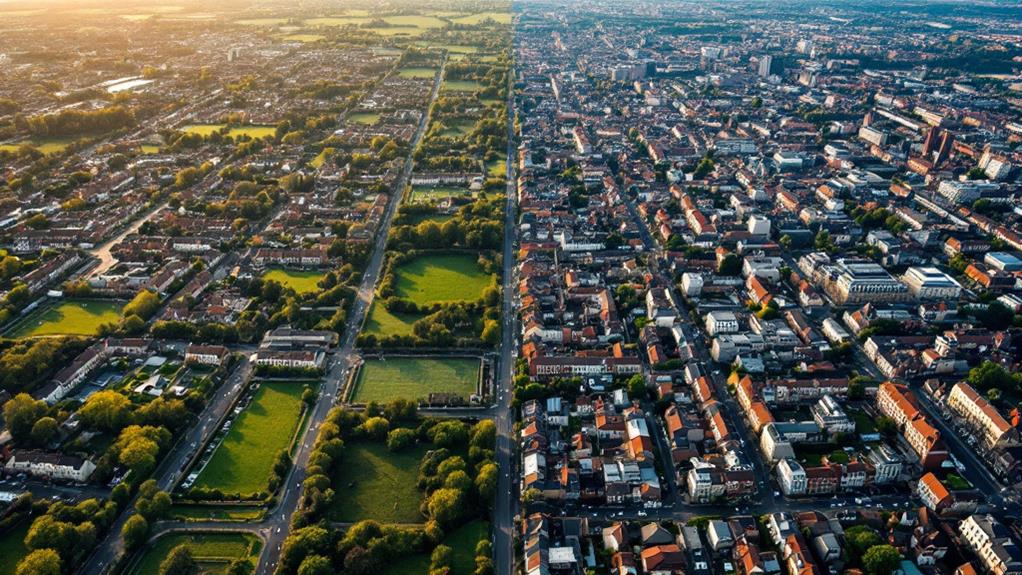Biggest Differences Between the Largest Cities in the U.S. and Europe

When you compare the largest cities in the U.S. and Europe, you'll notice major differences. European cities like Paris have higher population densities at 53,000 people per square mile, while New York City sits at 28,000. European urban areas are compact, a result of their rich history and thoughtful planning, contrasting with America's sprawling cities due to suburbanization. The U.S. relies heavily on cars, whereas Europe leans on efficient public transport. These cities also face different economic disparities, with the U.S. boasting higher per capita GDP. Historical development patterns and urban layouts further deepen these distinctions. There's more to this fascinating comparison.
Urban Density Differences
Urban density is a defining characteristic that sets U.S. and European cities apart. When you look at population density, European cities like Paris stand out with impressive figures—53,000 people per square mile. In contrast, New York City, one of the largest cities in the U.S., has a density of 28,000 people per square mile. This stark difference highlights how European urban areas pack more people into tighter spaces, creating lively environments.
In the U.S., the trend of suburbanization has led to sprawling urban layouts. Many of the largest cities don't even reach populations of 2 million, which naturally keeps their density lower. You'll find that this is quite different in Europe where larger cities contribute to higher average densities. European cities in the top ten by size often surpass the 2 million population mark, resulting in more compact and densely populated areas.
Moreover, Zipf's law implies that while no European city may reach the sheer size of New York or Los Angeles, the inherent design of European cities supports a higher population density. This creates spirited, densely-packed urban centers that are a hallmark of European living.
Population Distribution Patterns
When examining population distribution patterns, you'll notice several striking differences between U.S. and European cities. The city population in America's largest metropolitan areas totals 164 million people, while European cities' populations reach only 102 million. This discrepancy highlights how population distribution varies markedly across continents.
In the U.S., six of the ten largest cities have populations under 2 million, whereas all of the top ten European cities exceed that number. This illustrates how urban spaces are organized differently, with American cities often sprawling outwards, while European cities tend to be more densely populated.
Several factors contribute to these population distribution patterns:
- Urbanization Rate: The U.S. has a higher urban population share compared to the EU.
- City Size: European cities are generally more populous at the top end.
- Regulatory Barriers: These limit growth in Europe, unlike the more flexible U.S. urban landscape.
- Mobility: Americans move more freely, impacting city population dynamics.
- Integration: Europe's incomplete integration affects city growth and development.
Understanding these patterns helps reveal why U.S. cities often grow outward, while European cities maintain denser cores. This insight into city population dynamics is essential for comprehending broader urban development trends.
Income Disparities

Income disparities between the U.S. and European cities reveal a complex economic landscape. If you compare the per capita GDP, you'll find a 35% gap between the U.S. and the EU, showcasing considerable income disparities. This isn't just about city size; instead, it's more about differences in average income. U.S. cities offer higher income premiums for living in large urban centers, with a 34% advantage compared to the EU's 30%. This highlights the greater economic benefits of American cities.
You might think that larger cities have a substantial impact on income levels, but they actually account for only 6-7 percentage points of the total income gap. The real story lies in the average income differences. Moving people to bigger cities in Europe wouldn't greatly close this gap. Regulatory barriers and lower intra-European mobility limit city growth, affecting productivity and average income levels compared to the U.S.
City Size Influences
As you consider income disparities, it's essential to understand the role of city size in shaping economic landscapes. In Europe, cities often boast a higher population density, greatly influencing urban life. For instance, Paris reaches an impressive 53,000 people per square mile, while New York City, a populated city, accommodates about 28,000 people per square mile. This density impacts everything from public transportation efficiency to housing availability. European cities, with their compact urban forms, contrast sharply with the sprawling suburbanization seen in U.S. cities.
- European cities often have a higher population density.
- Paris: 53,000 people/sq mile versus New York City: 28,000 people/sq mile.
- Urban sprawl in the U.S. leads to lower density city centers.
- European cities maintain a more compact urban form.
- Regulatory barriers influence city growth differently in Europe.
The historical development of these regions plays a role, with European cities having more time to grow and develop compared to their American counterparts. In Europe, regulatory barriers and incomplete integration keep many cities smaller than their potential size. Meanwhile, U.S. cities, despite their larger geographical spread, often have fewer residents in their most populated cities due to these sprawling suburban areas.
Economic Implications

One can observe notable economic implications arising from the differences between U.S. and European cities. In the U.S., larger cities generate a considerable income premium, contributing to a per capita GDP gap of about 35% compared to the EU. With 164 million people residing in America's 50 largest metropolitan areas, US cities have a distinct advantage regarding economic output. In contrast, the Euro area's largest cities house only 102 million people, which limits their economic prowess.
You'll notice that the smaller average size of European cities is responsible for about 75% of the GDP gap. This indicates that having more people concentrated in large urban areas markedly enhances productivity and income. However, city size alone doesn't explain the entire economic disparity. The difference in large city population shares accounts for only 6-7 percentage points of the income gap.
Regulatory barriers and lower intra-European mobility further hinder EU cities from harnessing economies of scale. In contrast, US cities can capitalize on their size to drive economic growth. These factors highlight how population distribution and regulatory environments impact the economic health of cities across both continents.
Historical Urban Development
The historical urban development of European and U.S. cities shows stark differences rooted in their timelines and growth trajectories. European cities boast centuries-old histories, giving them an architectural and cultural depth that American cities lack. New York City, for instance, didn't begin its rapid growth until the late 19th century, while many European cities had already been thriving for hundreds of years. This difference in era and development means that U.S. cities often have fewer historic sites and a more modern urban layout.
- Centuries-old European cities vs. newer American ones
- Higher population density in European urban areas
- New York City's late 19th-century growth spurt
- Absence of large pre-colonial urban settlements in the U.S.
- Post-WWII urban revival in the U.S.
Before European colonization, the largest indigenous settlement, Cahokia, housed merely 18,000 people and was abandoned by 1350, highlighting the lack of substantial urban centers in the U.S. The urban fabric of U.S. cities is generally younger and smaller compared to Europe's extensive, established metropolises. Additionally, Europe's cities have long-standing urban landscapes developed over centuries, while recent trends in the U.S. have seen younger populations returning to urban centers post-World War II. This contrast sets the stage for unique differences in city planning and population distribution between the continents.
Suburbanization Trends

Exploring the modern landscape of U.S. cities reveals a notable shift towards suburbanization post-World War II, marking a departure from the dense urban cores typical of European cities. Suburbanization trends in the U.S. were fueled by affordable housing, improved transportation, and federal loans with low down payments. These factors made it easier for families to purchase homes outside city limits. However, this suburban migration wasn't without its issues, especially for African Americans. Discriminatory lending practices often excluded African American families from accessing these opportunities, embedding socioeconomic disparities and generational poverty in urban areas.
The phenomenon known as "white flight" exacerbated urban decline, as mainly white families moved to the suburbs, leaving behind neighborhoods that struggled with abandonment and crime. Businesses closed, and urban centers, once lively, faced notable challenges. In contrast, European cities experienced less suburban sprawl. Their strong public transportation systems and urban planning focused on density and accessibility have prevented such widespread suburbanization.
As you consider these differences, it's clear that suburbanization trends have shaped U.S. cities in distinct ways, impacting African American communities and contributing to complex social and economic landscapes that differ notably from their European counterparts.
Transportation and Urban Layout
When comparing transportation and urban layouts, you'll notice a stark contrast between U.S. and European cities. In Europe, public transportation systems are superior, providing easy access and connectivity throughout compact urban layouts. This contrasts with U.S. cities, where sprawling suburbs have led to a reliance on private vehicles. American road networks often disrupt neighborhoods, whereas European cities focus on integrated transportation options, maintaining a sense of community and accessibility.
In U.S. cities, skyscrapers dominate the skyline, with New York City boasting 287 of them. These structures symbolize prosperity but often come at the cost of disrupting the urban landscape. European cities, in contrast, strategically place skyscrapers away from historic centers, preserving cultural landscapes and allowing urban layouts to retain their unique character.
The trend of suburbanization in the U.S. post-World War II contributed to dispersed urban layouts, making car travel crucial. Meanwhile, European cities emphasize high population densities with compact designs, promoting walkability and efficient public transportation.
Key differences to note:
- U.S. reliance on private vehicles vs. European public transport systems
- Skyscraper dominance in U.S. cities
- Community-focused European transport networks
- Higher European population densities
- Preservation-oriented European urban planning



